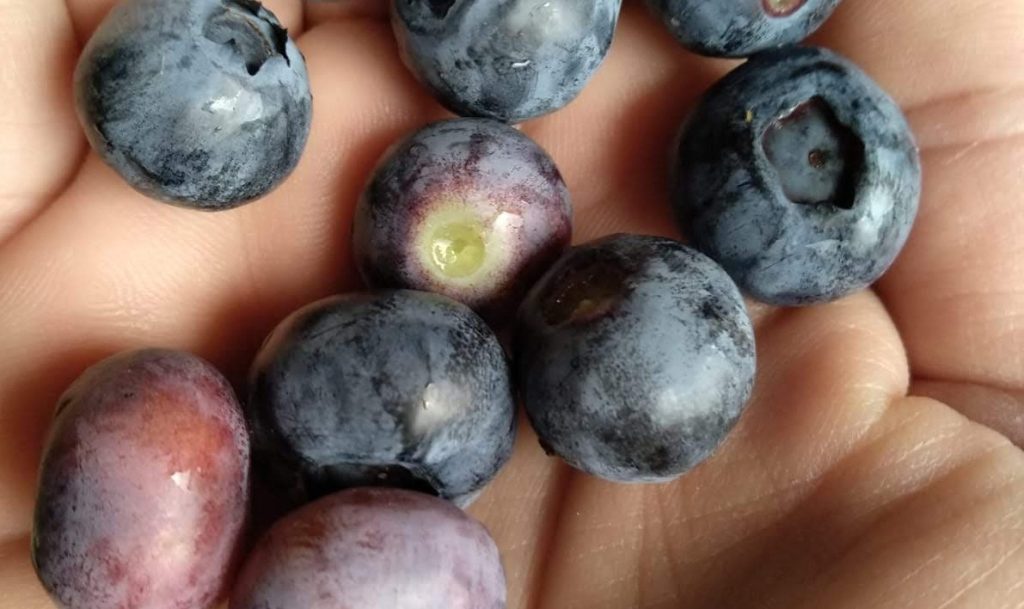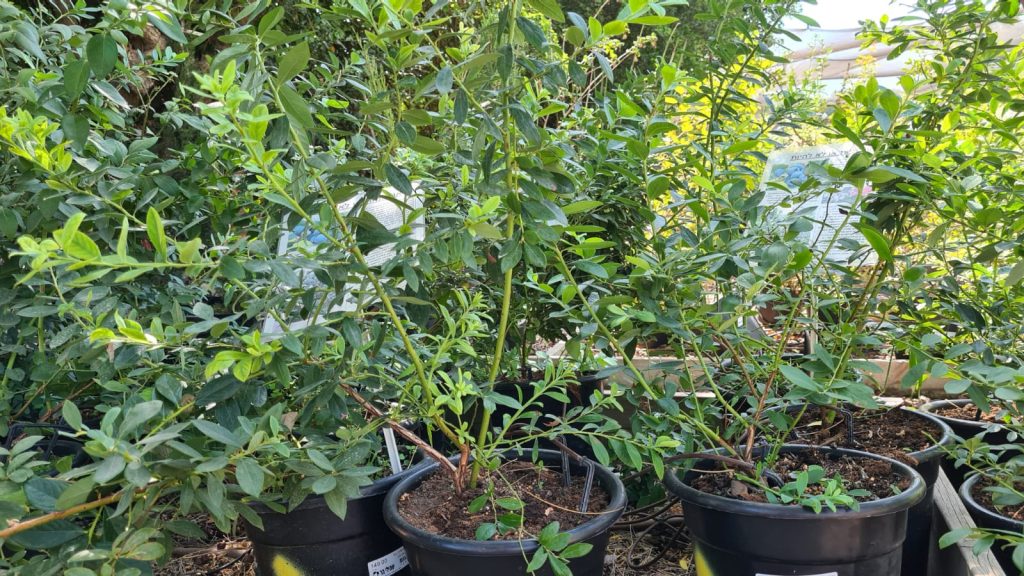
Blueberry – Vaccinium
Family: Ericaceae | Origin: North America
The genus Vaccinium of the Heather family contains many species, including various berries, some of which are not known in Israel. Most species require acidic soil and very low temperatures in the winter, so they were difficult to grow in Israel, but over the years, varieties and hybrids have been selected with low cold requirements. These plants can be grown in Israel and even on the coastal plains, as long as they are provided with the appropriate level of acidity in the soil.
The blueberry fruit contains many antioxidants and is considered extremely healthy, and its unique taste and bluish color are very attractive.
It is interesting to note that the only plant from the blueberry family that is native to Israel is the Arbutus andrachne (Ktalav) tree, which has sweet red-burgundy fruit that dry into delicious raisins. It is a beautiful tree with a red trunk and abundant white flowers that are very similar to those of blueberries.
All the blueberry varieties that we sell prefer to grow in pots of 20-30 liters or more for the smaller varieties and 50 liters or more for the larger varieties. They all like soil that is rich in organic matter and well-drained, with a pH of 5-6 and low salinity. By applying sulfur powder 2-3 times a year and regular watering and fertilizing, you can grow healthy and strong bushes for many years in the same pot.
Blueberries need direct sunlight for at least 3-6 hours a day. All varieties will also bear fruit on their own without the need for cross pollination.

?How to choose a blueberry variety to grow at home
In recent years, many varieties with low cold requirements have been distributed in Israel, but in our opinion, when choosing a plant for home growing, it is worth taking into consideration additional factors such as final size, sensitivity to suboptimal care, susceptibility to diseases, etc.
Therefore, we will recommend here a small number of varieties, which experience shows are the easiest to grow and thus also the most satisfying and suitable for everyone:
:Sunshine
a highly recommended variety because of its compact size (a mature bush in a large container will reach 1*1 meters), its insensitivity to diseases and its resistance to problems in fertilization and soil acidification. It has small leaves and dense growth and usually bears fruit in the middle of the season for a relatively long period and sometimes even in two waves with the first fruits on the coastal plain as early as April. It is evergreen even in cold winters.
:Ann
a variety whose name was invented in Israel and is not identified with certainty that does well on the coastal plain and is not fussy at all. It has larger, rounded leaves and its growth is narrow and relatively upright so that it can reach a height of 1.5 m with excellent growth. An early fruiting variety that on the coastal plains can ripen fruits as early as February-March. When picked, the old petals cling to the fruit, so it is less popular in the trade, but excellent in a private garden.
:Gulf Coast
a variety developed for the warm coastal areas of the southern United States that is very compact(50*50 cm when grown well) and is therefore also suitable for small containers in small balconies. It has low cold requirements and is not very fussy. It usually produces fruit just after 'Sunshine'.
:David (probably 'Abundance')
a variety with moderate cold requirements, that may be less recommended for the coastal plain areas right next to the sea. A very large bush with large fruits. Suitable for those who are willing to commit themselves to growing it in large containers, to acidify and fertilize very regularly, and to prune when necessary. The Prize – exceptionally large and delicious fruits. Recommended mainly for those who have already successfully grown the easier varieties.
:Biloxi
a prolific variety with no cold requirements. Seemingly highly recommended and therefore also common in Israel in recent years, but due to its size and rapid growth rate and its high fertilization requirements, it requires more space and attention. We recommend it mainly for those who have already successfully grown the easier varieties.
:Titan
a large variety with huge fruits that has recently been distributed in Israel. From the Rabbit's Eye group, which are large, deciduous varieties with relatively high cold, fertilization and acidification requirements. Recommended for advanced growers who can grow it in a large container, probably with a preference for the high mountain area.
Note: This variety has some self-pollination, but will yield more fruit in the presence of another variety from the same group.

Both you and I can grow blueberries
:Purchase
Choose a plant with many healthy leaves. If the plant is wobbling in the pot, it's a sign that the root system is not developed enough. This is a common problem, as Blueberries are slow root growers and it is recommended to verify the nursery's level of responsibility in the event of a failure.
:Planting containers
It is recommended to keep the plant in its original container for a while, especially at the height of summer. If the plant is very healthy and large relative to its container and the root ball looks full and very stable, one can transplant it even in the summer, but only to a container two to three times larger in volume, i.e. from a 3-liter pot to an 8-10 liter one or from a 7-10 liter one to a 20 liter one.
Blueberries have a relatively shallow root system which never grow very large, and it is advisable to prefer wide containers that are not very deep and to make sure that the container has many drainage holes also on its lower edges and not just at the bottom.
The drainage holes are designed to remove excess water and introduce air into the substrate, and holes in the sides of the pot are more effective in ventilation than holes in the bottom.
:Acidification and planting substrate
Blueberries must grow in acidic soil. Most soils in Israel are alkaline, and even the acidic ones (such as the basalt of the Golan Heights) sometimes contain a lot of lime and clay, which makes it very difficult to acidify the soil.
Therefore, blueberries must be grown in containers in a detached substrate, and any high-quality, aerated potting soil with good drainage is suitable. Sulfur should be added to the soil about three times a year, which, when broken down by soil bacteria, acidifies the root environment.
It is recommended to mix the sulfur powder well and dissolve it in a smaller amount of water than the amount of daily irrigation (if you water 4 liters per day, dissolve it in 2-3 liters of water) and water the entire surface of the substrate. You can also sprinkle the powder relatively evenly over the surface and then water it manually to dissolve it, even if you usually water it by drip irrigation.
Organic planting soils have a tendency to decompose and sink. Therefore, tuff from the Golan is often added to stabilize and prevent the soil from sinking and compacting. If you used a soil that lacks tuff or another stabilizing agent, you will see a slow sinking of the soil in the pot and it is recommended to occasionally add a small amount of soil from above, if the roots of the plant have been exposed (but without burying the bottom of the branches).
Once every two to three years, after harvesting and at the same time as pruning a healthy plant, you can remove the plant from the container and add new planting soil, mainly at the bottom. Then it is also recommended to lightly prune a particularly tangled or dense root system. After such treatment, it is advisable to partially shade plants that are in a lot of sun.
Watering:
Blueberries are very sensitive to drying out, but also to excess water in the soil. In the summer, it is recommended to water once a day or two with an amount of about 20% of the volume of the planting soil in the container – for a 10L container, about 2L of water per day, for a 20L container, about 4L of water per day. (If watering once every two days, water a 10L container with about 4L each time). It is advisable that the irrigation moistens the entire volume of the medium and you see a little water runoff coming out of the drainage holes. If the there is no water runoff from the pot, one should water in excess at least once or twice a week, so that you see significant runoff.
Blueberries are very sensitive to excess salts in the soil, and the water and fertilizer add salts, so by watering in excess we flush the medium and prevent it from accumulating salts.
All stated amounts of water are approximate and depend on various elements such as: temperature, air humidity, Sun radiation, the ratio between the size of the container and the size of the plant etc. so there may be significant differences. Use discretion.
When irrigating with drippers, it is a good idea to place at least two drippers on both sides of the plant, and in large containers even 3-4 drippers to evenly distribute the irrigation and rinsing.
:Fertilization
We prefer and recommend using slow-release fertilizers such as Osmocote and others that also contain trace elements and release tiny amounts of fertilizer over a long period of time. You should bury the granules under the soil in several places in the pot about twice a year. check the specifications of the fertizer for the right amounts.
We do not like using 20*20*20 fertilizer due to the risk of salting the substrate and burning the roots.
Liquid fertilizers can be used, as well as a fertilizer connected to the irrigation system, but then it is worth paying double attention to the fertilizer recommendations and washing the soil to prevent salting. It is important to remember that blueberries, like most plants, will suffer more from excess fertilizer than from a lack of it.
Please note: Do not fertilize unhealthy plants before understanding the cause of the problem, as fertilization can sometimes worsen the situation.
:Sun
All varieties of blueberries can grow in full sun, but if purchased in the summer, it is advisable to initially place them in partial shade and with a maximum of 4-5 hours of direct sunlight. It is also recommended to be careful and prefer 3-6 hours of direct sunlight, unless you have already acquired confidence and are sure that the plant is receiving optimal care. It should be remembered that black plastic containers and dark glazed clay pots heat up very much in the sun, which may endanger the root system, so it is better to shade the container by hiding it or by planting delicate sprawling plants in it. Ideally, the entire plant should be shaded with a 30-50% shade net, as most professional growers do.
:Pollination
All blueberry varieties sold in nurseries are self-fertile, but better pollination and larger and more numerous fruits are obtained by cross-pollinating plants from different varieties. All warm-climate varieties cross-pollinate and we recommend that you grow several plants so that they all produce more fruit. Natural pollination occurs mainly with the help of bees and to improve yield we recommend that you plant near the blueberries bee-attracting plants that bloom in autumn, winter and spring at the same time as the blueberries, such as rosemary varieties, various sages, 'Magic Mountain' basil and others. This is especially true if you live on a high floor where few bees reach.
Alternatively, the flowers can be pollinated by transferring pollen with a fine brush or by gently shaking the flowers, for example with an electric toothbrush and releasing pollen (in this case, only self-pollination will occur).
:Pruning
It is a good idea to start pruning dense plants from the age of three. Pruning is designed to open up and ventilate the plant to protect against fungi and encourage new growth, which will bear more fruit because old branches tend to accumulate pests and weaken after 3-5 years. You can gradually prune branches that have finished bearing from late spring after harvesting the fruit by shortening the branch to a height of 40-50 cm. In a healthy plant, old or diseased branches that are not completely green should be shortened low and 3-5 relatively upright branches should be left with spaces between them. If you pruned the plant all at once in late spring or summer, it is worth reducing watering and fertilizing and adjusting them to the smaller amount of foliage.
It is recommended to apply a protective coating to the stumps of large branches and continuously monitor the young, budding leaves for pests. It is not advisable to prune before winter or in winter, as evergreen plants will have difficulty budding in the cold.
Such pruning can be done every year to obtain a large amount of new growth and abundant, high-quality fruit, but it is also possible to prune heavily only once every two years and intermittently when there is no pruning, thin out dense growth a little for ventilation.
:Pests
Blueberries can be attacked by fungi and aphids, but one of the most common pests is a small insect called thrips that looks like a narrow greenish or black line. Different species of this pest attack the flowers, fruits and leaves of the plant, gently gnaw them, and the cumulative damage can be severe. We recommend to examine the plant often for damage and to bring damaged leaves and flowers to the nursery for inspection. There are many materials available to treat thrips and if necessary, choose an appropriate material and spray the plant.
A healthy plant in optimal growth tends to suffer less from pests.
:Birds
These charming animals love fruit and will sometimes want to share with you. If there is a significant problem, try a scarecrow, or a shiny pinwheel, or wrapping the bush in netting when the fruit is ripening.
It my seem complicated, but most of our recommendations are suitable for a wide variety of plants planted in containers, and if you have green fingers, we are convinced that you will succeed in growing blueberries and will enjoy the wonderful fruits for many years.
Good luck!
לקריאה בעברית על האוכמניות לחצו כאן

